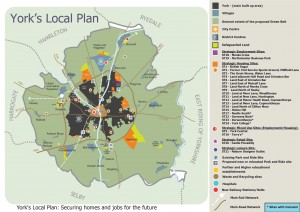Details are beginning to emerge of Labours attack on the (draft) York Green belt boundaries.
The full reports can be read by clicking here
We forecast this possibility last week but never guessed at the the scale of the attack
Apparently they plan to build on 640 hectares of land; much of this will be at green field sites.
They have quoted a (laughable) figure of 1090 new homes built each year with a total new build of 22,000.
That is twice the size of Huntington and Haxby combined or 20 times the size of Copmanthorpe!
Annual house building rates in York are currently below 300 a year.
This isn’t because of a limited supply of building land.
Thousands of potential homes could be built at previously developed sites like British Sugar, York Central, Nestle South and Terry’s not to mention other sites with planning permission such as Germany Beck and Derwenthorpe.
Low building completions have more to do with mortgage availability and onerous planning conditions.
The release of huge amounts of green belt land for building is likely to depress land values but it will also depress the value of existing homes leaving many ordinary people with “negative equity” problems.
And the effect on public services would be devastating. The City’s roads are already crumbling. Congestion is a major issue on many transport links near Labours “new villages”. Flooding and poor drainage cause chaos in the City. Many schools have limited spare space. The health service is under pressure.
Nor would it do much to help the affordable housing problem. The Council would be fortunate to get a 25% “affordable” contribution from these (privately owned) new sites .
There are over 4500 people on the housing waiting list although most are living in overcrowded accommodation (so they would free up a property for a smaller family when they move on).
A huge indiscriminate increase in the availability of empty houses would simply mean the City would – towards the end of the 15 year plan period – have to accommodate more inward migration.
It could become a dormitory town for Leeds.
But perhaps that is part of Labours real plan.
Over the next few days we will publish an analysis of the Labours building proposals and impact that they could have on our City and on local communities.






